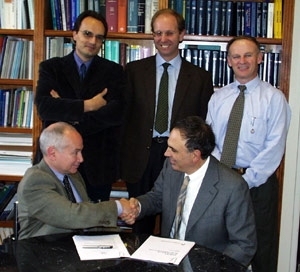MILAN, Italy--Pirelli Labs, the new high-tech center of the Pirelli group, and the Microphotonics Center of the Massachusetts Institute of Technology (MIT) have announced a five-year-long framework agreement for advanced research in the field of photonics. In the first year Pirelli Labs will make an investment of $2 million.
MIT has pioneered the use of nanotechnology in realizing optical integrated circuits (ICs) capable of high-level functionality. In addition to groundbreaking research creating the building blocks of optical ICs, MIT researchers have for the first time demonstrated that such building blocks--waveguides, bends and splitters--can be integrated with active structures such as lasers, amplifiers and modulators.
Pirelli and MIT scientists will study a new generation of integrated optical systems based on nanotechnologies. Pirelli's goal is to utilize all of the wavelengths available in a fiber-optic cable to maximize the amount of data transmitted on each fiber and create a breakthrough in the field of broadband telecommunications.
Soon everyone, right up to the final subscriber, will have access to very high bandwidth. The results of this joint research will be developed by Pirelli. Pirelli expects to make it available to the optical communication systems market by the beginning of 2004.
Under the agreement, visiting scientists from both organizations will work in MIT laboratories and the new clean rooms of Pirelli Labs near Milan. The latter are advanced laboratories devoted to research and production of optical components for telecommunications based on nanotechnologies (0.0001 mm size) and will occupy about 5,000 square meters in the new Pirelli Labs building.
"This agreement further strengthens the Pirelli leadership in the research and development of ever more advanced products and solutions," remarked Giorgio Grasso, CEO of Pirelli Labs-Optical Innovation. "Nanotechnology constitutes the future of optical fiber telecommunications, as it will permit the miniaturization and large-scale integration of optical components with a consequent reduction in the manufacturing costs as production volumes increase."
The goal is to provide very high quality services over an ultra-broadband to the residential subscriber. Pirelli--maker of the first fiber optical amplifier--has invested since the end of the '80s in the field of optical telecommunications. For this field to be profitable, it requires nanotechnology to lower the costs.
"The Research Alliance with Pirelli Labs joins MIT with a world class R&D center in the field of telecommunications components and related technology," said Professor Lionel Kimerling, Director of the MIT Microphotonics Center. "Pirelli's vision for the use of nanotechnology for photonic integrated circuits is coincident with the research program of the MIT Microphotonics Center. We expect to benefit greatly from the applications focus that this industrial partnership brings."
The Pirelli-MIT Research Alliance for Microphotonic Circuits will be managed by a joint Board of Governors consisting of three representatives each from Pirelli and MIT.
Pirelli Labs, with a facility of 13,000 square meters in the Milano-Bicocca area, represents the apex of the Pirelli Group's advanced research and is directly connected to all of the Pirelli research centers worldwide, as well as to important universities, with the objective of developing synergies between basic research and applications. In the field of nanofabrication, Pirelli Labs can count on the most sophisticated equipment both for research and for production: the Labs' mission is to realize prototypes of new technology, which are to be spun-off to specifically created high tech companies.
The MIT Microphotonics Center research addresses the use of new materials, devices and architectures for integrated photonic systems. MIT faculty and students will work with Pirelli Labs scientists and engineers in vertically integrated groups whose responsibilities range from design to the fabrication of functional prototypes.






